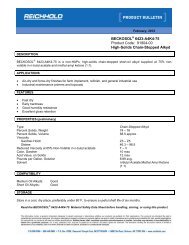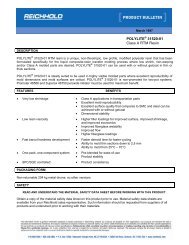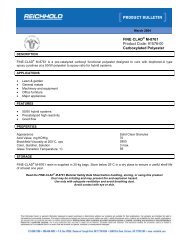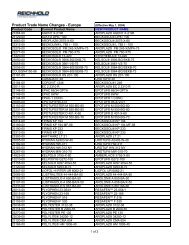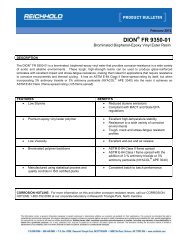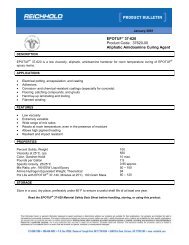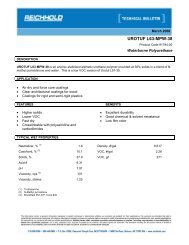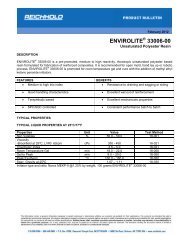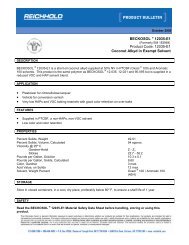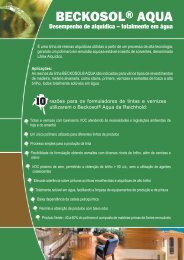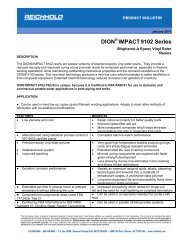CORROSION GUIDE 181108_new table content format ... - Reichhold
CORROSION GUIDE 181108_new table content format ... - Reichhold
CORROSION GUIDE 181108_new table content format ... - Reichhold
Create successful ePaper yourself
Turn your PDF publications into a flip-book with our unique Google optimized e-Paper software.
Common Types of Metal Corrosion<br />
Hydrogen Embrittlement<br />
Atomic hydrogen can diffuse or become adsorbed into<br />
steel. It then reacts with carbon to form methane or<br />
microscopic gas <strong>format</strong>ions which weaken and detract<br />
from ductility. Usually this happens at high temperature<br />
under conditions where FRP is ordinarily not considered.<br />
The same type of mechanism of attack is associated<br />
at lower temperatures with various forms of galvanic<br />
or stress induced corrosion. Quite often hydrogen<br />
embrittlement can be a problem for steel which has<br />
been electroplated or pickled, especially when done<br />
improperly or ineffi ciently. Some of these matters are<br />
receiving more attention due to future considerations of<br />
hydrogen in fuel cell and other energy applications.<br />
Sulfate Reducing Bacteria and Microbially Induced<br />
Corrosion (MIC)<br />
Colonies of microorganisms, especially aerobic and<br />
anaerobic bacteria contribute greatly to corrosion of<br />
steel through a wide variety of galvanic and depositional<br />
mechanisms. Usually the corrosion is manifested in the<br />
form of pitting or sulfi de induced stress cracking. Perhaps<br />
the most signifi cant type of such corrosion involves<br />
sulfate-reducing bacteria (SRB), which metabolize<br />
sulfates to produce sulfuric acid or hydrogen sulfi de.<br />
Such bacteria are prolifi c in water (including seawater),<br />
mud, soil, sludge, and other organic matter.<br />
These bacteria are a major reason why underground<br />
steel storage tanks are corroded, and this has<br />
lead to widespread use of FRP as an alternative or<br />
as an external protective barrier to steel. Various<br />
manifestations of MIC are seen far-and wide, including<br />
industrial environments which inadvertently serve as<br />
warm or nutrient-rich cultures for biological growth.<br />
FRP is unaffected by many of the mechanisms<br />
associated with MIC.<br />
Apart from sulfate reducing bacteria, other forms of<br />
microbial corrosion which affect metals include acid<br />
producing bacteria, slime forming organisms, denitrifying<br />
bacteria which generate ammonia, and other corrosion<br />
associated with various species of algae and fungi.<br />
It is expected that biologically induced corrosion will<br />
receive increased attention as more applications and<br />
technologies evolve in the fi eld of energy production<br />
associated with biomass and re<strong>new</strong>able resources.<br />
Processing will include such things as aerobic and<br />
anaerobic digestion, fermentation, enzymatic hydrolysis<br />
and conversion of cellulose, lignin, or polysaccharides<br />
to sugars, which in turn may be converted to ethanol.<br />
Carbon and stainless steels are not the only metals<br />
affected by MIC. Also routinely corroded are copper and<br />
various alloys as well as concrete. The most common<br />
example of which involves sewage and waste treatment<br />
applications in the presence of the thiobacillus bacteria,<br />
which oxidizes H 2 S to sulfuric acid. FRP has a long<br />
history of successful use in these environments.<br />
48



